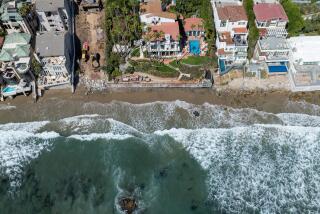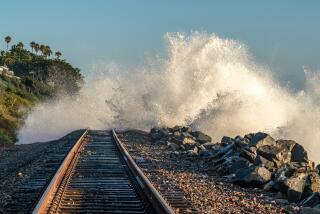A Sedimental Education
- Share via
This is not an underground comic strip or a cult TV series peopled with quirky eccentrics. This is Pasadena, where a real-life person owns 1,000 baby food jars full of sand.
“It’s fun, it’s beautiful and it’s exciting,” says collector Dave Douglass. Granted, Douglass is a geology professor at Pasadena City College, but sand wasn’t his academic focus (actually, his 1987 Dartmouth College PhD thesis explored “Geology and Paleomagnetics of Three Old Red Sandstone Basins: Spitsbergen, Norway and Scotland”). No, the same guy who posted William Blake’s “world in a grain of sand” poem on his Web site has students and friends trolling the globe for samples simply because he loves the stuff.
For those oblivous to the grainy stuff when it isn’t in their bathing suits, sand, like its cousins silt, gravel and clay, belongs to geology’s sediment family (sediment being fragments created by the breakdown of rocks). Sand grains are between a sixteenth of a millimeter to 2 millimeters in size, and--balm to the collecting soul--come in a dazzling array of materials, colors, shapes and textures.
As with so many collectors, “Dr. Dave’s” life has a before-and-after quality. Until about 10 years ago, he never gave sand much thought. “You take it for granted.” But his former wife, a collector fond of travel, got him hooked. Today Douglass, 44, has sand from Nepal and sand from miles below the San Andreas Fault. He has red sand from Ayres Rock in Australia, green sand from Hawaii and black sand from British Columbia. He has sand scooped by a friend from a leech-ridden stream in Burma. He has sand from eerily acoustic “squeaking” or “booming” dunes such as Nevada’s Sand Mountain and the Kelso Sand Dunes in San Bernardino County.
Among collectors, he isn’t an extreme case: The director of the International Sand Collectors Society has 11,000 varieties in vials, Douglas says. While rivalry exists as to collection size, Douglass says members (from 17 countries) don’t sell for profit. “Some collectors trade, but I don’t do much of that. I have an advantage because my students bring me sand when returning from vacations.”
The ultimate prize? Extraterrestrial sand. “The most sought-after is from the moon. NASA has it, but it’s hard to get. I knew someone who had some because he worked in aerospace, but he wouldn’t give me any.” Douglass adds that though NASA simulates Martian sand, no private collector owns the real thing.
For Douglass, a grain of sand displays the wonder of what he likes to call “life on the alluvial fan.” “The best thing about sand is that people think they know what it’s like, but when they look closely they see the variety and different colors, and the little sea creatures, and get excited thinking about the world,” says Douglass, whose Web site (www.paccd.cc.ca.us/sand) offers collector kits and an address where he’d be delighted to receive a sample or two. Contributions may be addressed to “The Sandman.”


